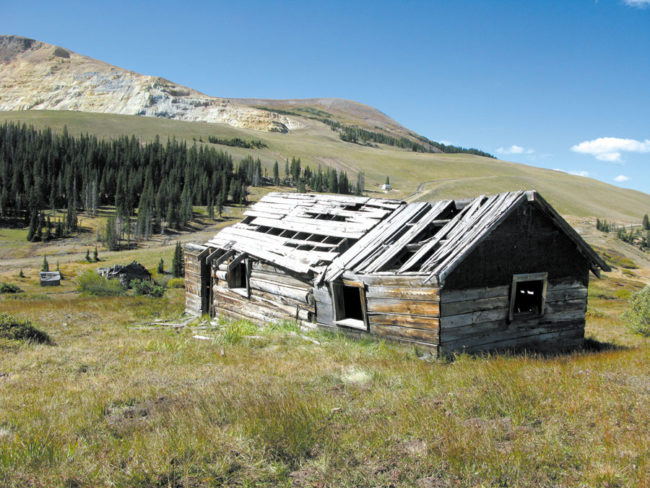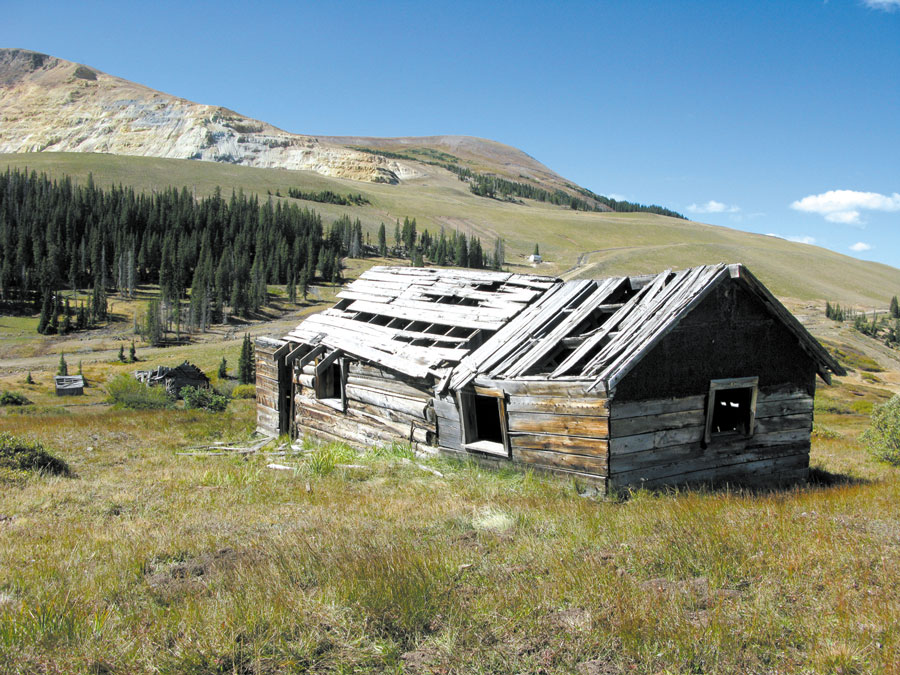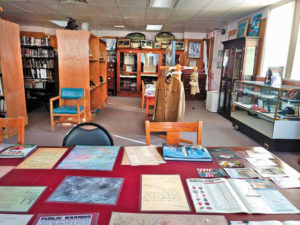By Kenneth Jessen
Editor’s note: Salida’s been making quite a few top 10 “Best Town” lists over the past few years, much to the chagrin of a few locals. We thought it would be fun to turn the table and list the worst Colorado towns of 100 years ago. We’ve listed them as worst for a number of reasons you’ll find as you read further. The first five towns have been chosen by author Kenneth Jessen. Part two, coming in April, will list the second five towns as determined by author Jan MacKell Collins.
Calling these towns the worst may be a little harsh. Today their beautiful setting, some along a clear stream and others tucked away in the mountains, obscures their past. They all share some kind of tragic event either with murder, eviction or contamination.
Granite – Judge Dyer Assassinated
There were rich placer deposits on the banks of the upper Arkansas River from Salida to the north. They were mined in the early 1860s. Several camps began to appear and some, like Granite, grew into trade centers. Granite was established in 1867 and a year later got its own post office.
The first industry was a small, two-stamp mill built by W. L. Millard and S. B. Kellogg. Soon a much larger mill was constructed by Lewis Hayden. Hayden built his mill for his own mine, and over $75,000 in gold (at today’s prices) was recovered during its first month of operation! A third stamp mill was constructed for ore from the nearby Yankee Blade Mine located to the northeast.
Granite became prominent in 1868 when it became the Lake County Seat, having taken that position away from Dayton by popular vote. The citizens of Granite contributed $500 to have the county courthouse at Dayton moved. As a side note, this was a two story log structure and the move would have been nearly nine miles. Dayton later became the town of Twin Lakes.
[InContentAdTwo]
It is never good for a town’s reputation when a judge is assassinated in his office. At eight o’clock in the morning on July 3, 1876, Judge Dyer presided over a trial involving the accused members of the so-called Committee of Safety. Charges were dismissed due to lack of evidence. The committee was part of a violent dispute generally referred to as the Lake County War. It started with a confrontation between established homesteaders and new arrivals.
Judge Dyer remained in the courtroom when five men walked up the steps to his office. Witnesses heard four shots. One ball struck the judge’s chair and another went through his arm above the wrist, then out the window. Cries of “spare my life” were heard in the street below. One man held the judge while another placed a pistol against the judge’s head and fired. The hair around the bullet hole behind his ear was burned. The five assassins left the room.
During the following days, testimony was presented before a six-man coroner’s jury. Witnesses recalled seeing the men on the steps of the courthouse just prior to the shooting. Among the witnesses was J. A. Woodward, and he was the only one willing to reveal the identity of the armed men. Woodward overheard threats made against the judge prior to the killing. Before he could testify before the jury, Woodward was shot to death – dead men don’t talk.
Granite had difficulty holding on to its title when Leadville began its unprecedented growth during the late 1870s. In 1878 Leadville’s population alone exceeded that of Lake County’s entire population the previous year. It became obvious that a new county had to be formed, and in February, 1879, the State Legislature created Carbonate County. This encompassed roughly the upper one third of the old Lake County with Leadville at its center. Just two days later in a confusing piece of legislation, the State changed the name of Lake County to Chaffee County and Carbonate County to Lake County. Granite became the Chaffee County Seat, but its tenure was short-lived. The following year, Buena Vista was declared the new county seat by popular vote. Later Salida superseded Buena Vista as the county seat.
Originally, placer miners along the Arkansas River near Granite used sluice boxes and Long Toms (an elongated form of a sluice box). Eventually this form of placer mining was replaced by hydraulic mining using high-pressure nozzles to wash the gravel down from the ancient streambeds and glacial moraines. Once this very destructive form of mining ended, gold dredges along the Arkansas River where brought in. As the placer deposits were exhausted, hard rock mining began. For many years, these forms of gold mining supported Granite’s economy.
As the mines got deeper, complex refractory ore was encountered. No longer could simple stamp mills, followed by amalgamation with mercury, extract gold. When Leadville boomed in 1879, Granite was relegated to a stage stop for the heavily traveled road along the Arkansas River. The following year, the Denver & Rio Grande constructed its railroad through Granite.
Granite is historic and worth a visit. The town sits just east and below U.S. 24 on the east side of the Arkansas River. The schoolhouse still stands, overlooking the valley, and there is an old abandoned store along Granite’s main street. Granite also has several log structures, and many are occupied by permanent residents.
Gilman – Drinking Water Contaminated
If ever a town was a cliff-hanger, it is Eagle County’s Gilman. At the edge of a bench on Battle Mountain, there is a steep 600 foot drop to the Eagle River. The camp began with an identity problem – it was settled as Rock Creek, renamed Battle Mountain then became the town of Clinton. In 1886 it was platted by Henry M. Gilman and named for him.
Below the town of Gilman were several mines and a large mill. When the Denver & Rio Grande constructed its line through Eagle River Canyon in 1887, the railroad siding along the Eagle River was called Belden. Gilman’s residents had rail service only if they were willing to climb down a long set of exposed stairs or used a funicular to the Belden station.
A variety of ore was found in the area, including silver, gold, zinc and copper. This is what sustained the population of Gilman for 99 years, one of the longest runs for a Colorado mining town based entirely on the recovery of ore. During its life, the mines yielded an astounding 393,000 troy ounces of gold plus other metals.
The town grew to include stores, a school and the Iron Mask Hotel. It even had a bowling alley. Half of Gilman was destroyed by fire in 1899, including the hotel. With a population of 300, the town was rebuilt.
In 1915 the New Jersey Zinc Company acquired the mines and recovered enormous quantities of metals. In 1981, with its ore reserves exhausted, the mine closed, and a Cañon City businessman purchased the town and mines. The next owner was the Battle Mountain Corporation which took title in 1984. What ended the town of Gilman was not the closure of the mine, but its drinking water. It was found to be laced with a plethora of heavy metals. The Environmental Protection Agency stepped in and in 1985 forced the town’s 60 residents to leave.
Gilman is on private property and is not only posted, but periodically patrolled. The town can be seen from U.S. 24, where there are several viewing locations. Gilman is located between Leadville and Minturn. The town of Minturn annexed Gilman in 2008 in hopes it would be developed into a ski and resort complex.
Duncan – Residents Evicted
There are well over 1,600 ghost towns in Colorado. Many are abandoned mining camps spread out over the western half of the state. Among the most obscure is Duncan, located along the western base of the Sangre de Cristo Mountains near the Great Sand Dunes National Park.
The history of Duncan starts in 1874 when John Duncan followed an old trail over Medano Pass into the San Luis Valley. At the mouth of Pole Creek, he discovered some gold-bearing ore that had washed down from the mountains. He constructed a durable cabin made of hand-hewn logs tightly locked together with corner notches. As word got out, other prospectors were attracted to the area, and in 1890 a town grew up around his cabin. Duncan then turned from prospector to town promoter, laid out the town of Duncan and sold lots for $25 each.
Duncan, however, wanted to return to prospecting and turned over the job of town developer to Charles Reed, owner and publisher of the Duncan Eagle. This was the camp’s weekly newspaper and cost all of $1.50 for a year’s subscription. Editor Reed published reports about the activities in and around Duncan, but also took sides in national politics. In 1896 Reed endorsed William Jennings Bryan for U.S. President. Bryan ran on a free coinage ticket that bolstered the price of silver in a fixed ratio to gold. Had Bryan won the election it would have benefited Colorado’s precious metal mines.
Stamp mills were constructed up Pole Creek to process the gold ore. These were primitive devices that crushed the ore into sand-like consistency. The pulverized ore was then mixed with mercury to amalgamate the gold. The mercury was separated leaving the gold.
In 1892 Duncan got its own post office and it remained open until 1900. Except Sundays, there was daily mail service for its 250 residents. This seems amazing considering how far removed the town was from Alamosa, the nearest population center. However, Duncan was on a north-south postal route that served a number of small towns along the base of the Sangre de Cristos. A “ride through” service was offered where a horseback rider could reach into his or her mailbox and retrieve the mail without entering the post office.
Duncan was a fairly large town, and based on a modern survey of foundations by the United States Forest Service, had as many as 50 structures. There were a variety of businesses including a dry goods store and two general merchandise stores. A freighting company, a couple of saloons, livery stable and lumberyard rounded out the businesses. Mrs. P. M. Harper operated a boardinghouse charging 35 cents a meal or $6 a week for all meals. Duncan had a physician, an attorney, a notary public and an assayer. A ditch was dug to divert some of the water from Pole Creek for use by town residents. Duncan also had a cemetery. Not only was there a north-south road, but another road came in from the west.
For the 18 school-age children, a school district was formed in 1893 by the parents. The school was a log building and served both Duncan and nearby Cottonwood. The last classes were held in 1899.
The town’s people paid for telephone poles and a wire was stretched across the San Luis Valley from Duncan to Hooper. Duncan citizens could now take turns talking to the outside world.
Living in Duncan was probably a struggle, and the gold ore was not all that rich, but its cabins were relatively comfortable. The view across the San Luis Valley was spectacular, including the sand dunes and the Sawatch Range.
Duncan came to a sudden end in 1899 when George Adams purchased the Luis Maria Baca No. 4 Grant. Duncan was inside the grant, and its citizens did not own their land, but were technically squatters. Adams contended that he not only owned the grazing rights, but mineral rights as well. A legal battle over land ownership ended up in the courts, and the ruling was in favor of Adams.
In 1900 the citizens of both nearby Cottonwood and Duncan were evicted by U.S. Marshals stationed in a temporary camp to carry out a court order. Home owners were compensated by the Baca Grant at $125 for each structure and were subsequently allowed to buy back their home for $10 providing that they move off the grant. All of Duncan’s buildings were either razed or moved except for the durable John Duncan cabin. It was converted for use by the ranch.
Fortunately for Duncan’s displaced residents, gold was discovered to the south at the mouth of Short Creek and outside the Baca Grant. As the residents of Duncan were evicted, some left the area while others moved to Short Creek and set up a new town they called Liberty. It was only about a mile away and no doubt, some of Duncan’s log cabins were disassembled and moved to Liberty. A post office opened and remained active until 1921. A stamp mill was built, but the ore was low grade, and Liberty was eventually abandoned.
Jumping ahead to 2000, Congress passed into law the Great Sand Dunes National Park Act authorizing the Secretary of the Interior to transition the Great Sand Dunes National Monument to a park through the purchase of the undeveloped southern portion of the Luis Maria Baca No. 4 Grant. The land was acquired through the Nature Conservancy and once the transaction was complete, the area was divided. The new Great Sand Dunes National Park, the new Baca National Wildlife Refuge and the Rio Grande National Forest all got portions of the purchase. The Forest Service received 13,000 acres of ranchland including the Duncan town site and the John Duncan cabin. Due to the historical significance of the cabin and its poor condition, it was decided to save the structure. During the summer and fall of 2011, three work sessions were set up for volunteers. The cabin was “de-constructed” log by log, the rotten course of lower logs was replaced and the cabin rebuilt. In all, an estimated 500 hours was put into the restoration. Future plans call for renting the Duncan cabin to those who wish a backcountry experience much like other restored Forest Service structures in the state.
Summitville – Cyanide Contamination

In 1870, prospector J. L. Wightman made the first gold discovery at the foot of South Mountain in Rio Grande County. Placer claims were staked and a mining district was formed. Gold was panned throughout 1870 until winter arrived. The following spring a new rush of prospectors came into the area, but poor yields discouraged most, and by the end of the summer, they left the area. Wightman plus two others remained and took their gold dust to Denver, receiving only $170.
They did not give up and when the source of the gold was discovered, it led to the establishment of Summitville, located at over 11,000 feet. A post office opened in 1876.
Summitville grew to become the largest gold producing camp in Colorado. The town’s population fluctuated from 300 to 600, enough to support 14 saloons and the publication of the Summitville Nugget.
After the high-grade ore ran out in 1887, the population fell and all of Summitville’s businesses closed. The owner of most of the claims, the Golconda Mining Company, was sold, and Summitville became a ghost town.
Summitville was reborn when large-scale mining to remove low-grade ore resumed in 1934. The post office reopened, and seventy new homes were constructed of milled lumber along with a bathhouse, bunkhouses and large dining hall. Summitville also got its own school and its population swelled to an estimated 1,500.
The mine continued to operate, but due to the harsh weather and deterioration of its buildings, Summitville was abandoned. Miners and mill workers were brought in by bus from Del Norte.
Mining ended in 1992 after a serious sodium cyanide spill. This toxic chemical is used to leach out the gold. The neoprene liner for heap leaching leaked the cyanide into a nearby creek, killing all life. The mine owner, Canadian Galactic Resources, soon filed for bankruptcy. The Environmental Protection Agency was left holding the bag for the cleanup. The Environmental Protection Agency spent $155 million on the site, and Galactic Resources paid around $30 million in settlement. This incident put Summitville on the map but not in a good way.
A visitor to Summitville will see about two dozen abandoned buildings sitting in a meadow and with a beautiful backdrop of high mountains. The ramshackle cabins are split into two groups: one by the road and the other on the hillside. The easiest way to reach Summitville is via County Road 14 (paved) from Del Norte, which becomes Forest Road 330 (graded). A second route is Forest Road 380 (graded) from U.S. 160.
Independence – Victim of Violence
At one time, there were tens of thousands of buildings in the Colorado mountains left behind from the mining era. Most were destroyed by fire while others were dismantled for their wood. Some were flattened by heavy snow while others rotted away over time. Independence, however, was razed in 2003 by the Cripple Creek & Victor Gold Mining Company to make way for the expansion of their open pit. The irony is that it was mining that built Independence and it was mining that destroyed the town.
Independence began as Hull City adjacent to the Hull City Placer. The homes were scattered across the hillside with some near the railroad and others near the mines. The post office originally went under the name Macon, and was opened in 1895. Its name was later changed to Independence. A handful of people remained in Independence well after the end of mining era. The post office did not close until 1954.
To haul ore to smelters a number of railroads were constructed to the mines including the narrow gauge Florence & Cripple Creek Railroad, the standard gauge Colorado Springs & Cripple Creek District line as well as the standard gauge Midland Terminal. All of these railroads came through or near Independence, which stimulated its growth. The town population reached of over one thousand.
Winfield Scott Stratton was Cripple Creek’s first millionaire, and it was the Independence Mine that made him rich. He was blessed with extraordinary luck and good fortune. On the Fourth of July 1891, Stratton was prospecting on the side of Battle Mountain. It was an area free of other mining claims and had been overlooked by prospectors. The geology of the mountain led Stratton to believe that rich gold ore could be discovered. As Stratton searched the barren hillside, he could hear miners off in the distance firing their revolvers into the air to celebrate Independence Day. Stratton didn’t have time to celebrate and when he found an outcropping of promising gold ore, he called his claim the Independence.
He borrowed as much money as he could and sold his Colorado Springs home. Stratton moved to the site of his discovery and lived in a tent. Eventually, Stratton was able to raise enough money to begin mining. Once the mine began to produce, he limited his daily profit to $2,000. In today’s money, this is equivalent to $22,000. For a man who had worked most of his life as a carpenter for $3 a day, this was quite a change. The Independence yielded an estimated quarter of a billion dollars during its life, and Stratton constructed a nice home near the mine in the town of Independence.
Independence has a dark side. It was the site of a deadly incident during the labor strike of 1903. The Western Federation of Miners recruited the notorious Harry Orchard to stir up trouble. The local union held out for a daily wage of $3 based on an eight-hour shift instead of the 10-hour shift demanded by the mining company. Area mines produced gold. During the 1890s the price of silver was on a steady decline, and in 1893 the United State went off the silver standard. This put many silver miners out of work, and the mine owners simply replaced the striking gold miners with unemployed silver miners. Only two of the 50 mines in the Altman-Independence area yielded to union demands.
After killing two non-union men at the nearby Vindicator Mine, Harry Orchard turned toward the Independence railroad depot. In June 1904 Orchard and an accomplice placed two boxes of dynamite under the depot platform during the night. When non-union miners began to congregate on the depot platform to go to work, Orchard set off the bomb. The explosion ripped the depot platform apart, blowing off one of the depot walls. There were 27 men on the platform and 13 were killed instantly. Body parts fell on the hillside above the depot. Among the injured, six were saved by amputation of arms and legs. One man died later of his injuries.
Orchard had gone camping at Cheyenne Mountain with some friends the evening before to establish an alibi. After his companions had gone to sleep, he quietly rode to Independence and set off the bomb. He returned during the night and climbed back into his tent. When his friends awoke in the morning, they were greeted by Orchard. Peace was finally restored and the mines continued to operate under the $3 for a 10-hour shift.
Kenneth Jessen lives in Loveland and teaches adult education at Colorado State University. Coming in the fall is his six-week course titled “Colorado Mines, Mills and the Rise and Fall of Mining Towns.” Jessen also has a new book, Frontier Colorado Gunfights.



